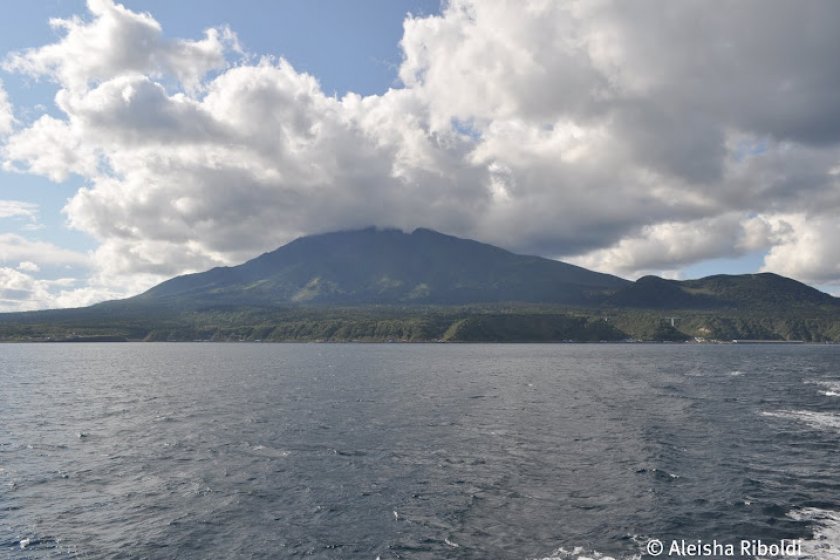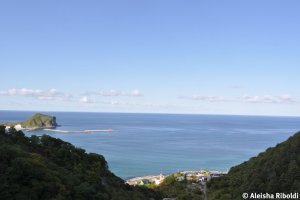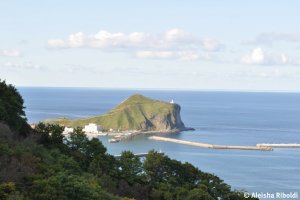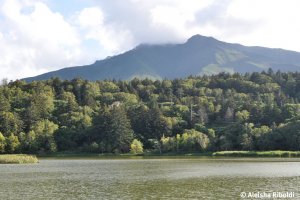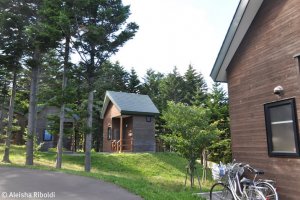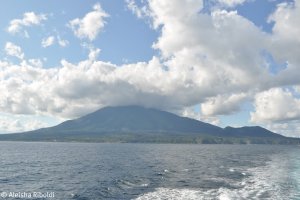No trip to Wakkanai is complete without a stopover at either Rishiri island or Rebun island, so Rishiri it was.
Having reached the northernmost point in Japan, the next part of our roadtrip was to spend a night at Rishiri, which lies to the west of Wakkanai out in the Sea of Japan. From Wakkanai Port, there are ferry services that run to both islands.
Rebun is the longer, thinner island, while Rishiri is smaller and rounder, covering a total landmass of approx. 183 square kilometres. It is home to about 6000 residents.
We had planned on taking the car across on the ferry, but given the price to take our vehicle we decided to leave in the carpark. Armed with a daypack, we made the journey across the Sea of Japan from Hokkaido's mainland to Oshidomari Port on Rishiri island.
The September skies were wonderfully clear and blue, perfect for taking a few scenic shots as we traveled across the water. We parked ourselves on an open stretch of carpet aboard the boat, tucked into our convenience store-bought lunch and had a bit of a nap. It’s a 3-hour journey from Wakkanai Port.
On approaching the island, it’s pretty hard to ignore the volcanic (thankfully, dormant) mountain, aptly named Mount Rishiri, which takes centrepiece on the island. It’s supposedly a full-day (6-8hour) hike to the peak, but that sounded like too much effort for us on this occasion.
Upon arrival, right outside the ferry terminal we hired rental bikes that only cost 2000 yen for 24 hours. We now had wheels – making the uphill journey to our camping ground a struggle, but definitely faster than walking. The camping area is atop a large hill, which is a little hardgoing on the bikes, but the view is worthwhile.
We didn’t have tents or other gear, but this camping ground offers cute, tiny (and I mean tiny) wood cabins for “luxury” campers who haven’t brought along their tents. Very basic furnishings – 2 sets of bunk beds (linen included), a small table and a heater. For less than 2000 yen we can’t complain. (A bungalow costs about 4000 yen per night, plus site fee of 500 yen per person, costs split between 3).
(If you prefer to sleep someplace more homelike and cozy, Pension Hera-san-no-ie might be more your style.)
Rishiri Island is a tiny, remote, laidback place. It’s great to explore nature and enjoy the great outdoors at a leisurely pace. Here, you can indulge in hiking and cycling, with an onsen at the end of the day to reward your weary legs. We opted for the cycling. There are 2 main bike tracks (and by tracks, I mean well-paved, wide, bicycle-specific lanes, not too strenuous either for my not-so-bike inclined self), which run right through the mountains and trees away from the traffic roads. They offer stunning views of the sea that surround the island.
We got in a good 20km cycle, just following the bikepath. We branched off onto smaller tracks following various signs pointing out natural attractions, one of which is Himenuma (Princess pond). Here, we alighted from our bikes and walked along the easy trail path that loops around the pond and gives a wonderful reflection of Mount Rishiri off its still waters. It’s a really pretty spot to take more pictures.
We cycled some more around the island, as we ventured out onto the road and along the coastline. How very “Sound of Music” of us as we pedaled around. For the more hardcore cycle enthusiasts, you could do a full-circumnavigation of the island.
It’s great to take in the fresh air, stunning scenery, get in some exercise and savour the peacefulness of the remote island that is Rishiri.
Bikes are highly recommended to get around, although it can be hilly in parts. Motorbikes are also available for rental.
Dining options seem somewhat limited but we were content with a local ramen and teishoku restaurant for a very late lunch/early dinner.
We also stopped by a local supermarket to get “camping provisions” (i.e. wine, plastic cups, chocolate, cheese and crackers). We pedaled back up the hill to our campsite and settled ourselves in to our bungalow.
Opposite the campsite is an onsen/health facility. Perfect. A nice long soak in an onsen to top off a day enjoying the outdoors is just what we wanted. This is my kind of camping.
There was little time the next day for further exploring as we headed back on the next boat back to Wakkanai. I would have liked to walk up Cape Peshi which is beside the ferry terminal but it looked steep and I was short on time. I imagine, though, that the views over the island from the point would be stunning.
I recommend cycling and camping on Rishiri Island. Camping ground Yuni offers bungalows or you can pitch your own tent for free (500 yen admission fee.)
Whilst car rental is available, be warned that petrol prices in this remote location are very high at 170yen per litre. We were glad we opted for the pedal power.
Things to do on Rishiri Island
- Visit Himenuma pond
- Hike Mount Rishiri
- Walk up to the top of Cape Peshi
- Onsen
- Cycle through mountains
- Explore the island by bike (excellent purpose-built bike paths and very little car traffic on this tiny island)
- Camp or stay in local ryokans/minshuku (a handful of campsites available). Try Camp Yuuni.
